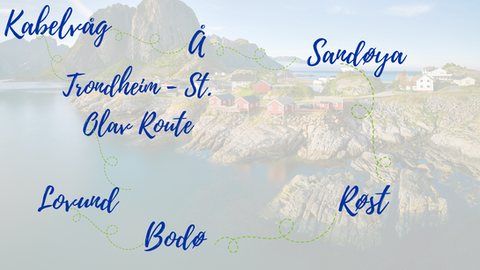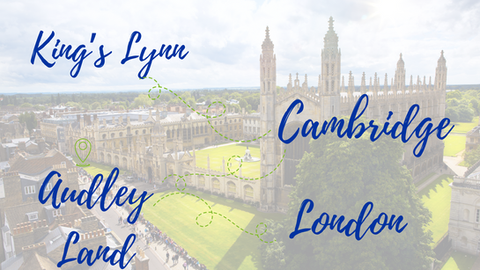Tourist pills
Start your journey along the Via Querinissima.
Discover the places visited by Pietro Querini and other places of interest.

Discover Via Querinissima in Italy
%20(5).png)
Venice
-
Calle della Malvasia: the fine wine that Pietro Querini produced and had to transport on his journey.
-
Rialto fish market: where the market now stands, it once housed the Querini family’s house.
-
Querini Stampalia Foundation: at the foundation, you can discover Venice from another less touristy aspect: in the Querini-Stampalia foundation there is a museum area, where there are art collections acquired by the family over the course of time.
-
Marciana National Library: a manuscript, believed to have been written by the Florentine Antonio di Matteo di Corrado de’ Cardini in 1433, is preserved at the library. The content is derived from the oral accounts of two sailors from Querini’s expedition, Cristoforo Fioravante and Nicolò de Michiele. Although the original work by Cardini has never been recovered, a version transcribed by Antonio Vitturi in 1480 is kept at the Marciana National Library in Venice (ms. It. VII 368 (7936). Furthermore, you can see the Globe of Fra’Mauro. Moreover, Marciana Library will be a honour members of Via Querinissima.
Sandrigo
The town of Sandrigo is strongly linked to Norway, in fact, it is twinned with the town of Røst.
In September, the Pro Loco di Sandrigo organises the “Festival del baccalà” – Codfish Festival, which attracts thousands of tourists and stockfish enthusiasts every year. During the festival, events and initiatives related to cod culture and gastronomy are promoted, and moreover, the last weekend of September sees the investiture ceremony of the new members of Confraternity of Bacalà alla Vicentina.
Furthermore in Sandrigo you can visit the headquarters of Pro Loco and the Confraternity of Bacalà and discover many interesting facts about Pietro Querini.
Rome
-
Vatican Apostolic Library: in the library is preserved the manuscript written by Pietro Querini (ms. Vat. Lat. 5256).

Discover Via Querinissima in Greece
%20(7).png)
-
Temene Castle: built in 961 by the Byzantine Nicephorus Foca, and extended under Venetian domination. The Querinis were assigned the fiefs of Castle Temenos and the Hamlets of Daphnes, to the north of the island, a few kilometres from the capital city of Candia.
-
Fountain with Querini’s family coat: located in the feudal estate that once belonged to the family.
-
Malvasia vineyards of Dafnes: these vineyards were the same ones used by the Venetian nobleman Pietro Querini to produce Malvasia and the owners are the descendants of a branch of the Querini family, the Dolfin.
-
Port of Candia (Heraklion): from the port of Candia, Pietro Querini set off on his voyage aboard the Cocca Querina, a typical Venetian ship, and a crew of 68 men.

Discover Via Querinissima in Norway
%20(8).png)
Kabelvåg
-
Lofoten museum: discover the contrast between life in the manor house and the authentic “rorbu” cabins. You will also find several boathouses with a large collection of traditional wooden boats as well as a fascinating “krambu”. In the Museum you can also find a book available both English and Norwegian about Querini's voyage.
Å
-
Stockfish museum: the Tørrfiskmuseum is dedicated to fishing in Norway, with a focus on stockfish fishing.
-
Norwegian fishing village museum: discover how Norwegian fishermen lived. The museum is one of the best preserved and most complete old fishing villages in northern Norway. You can discover and immerse yourself in the harsh and picturesque life of a Lofoten fishing village.
Røst
-
Pietro Querini literary park: Pietro Querini Literary Park was established in 2017 and is dedicated to Querini’s unique description of the landscape and popular life in Røst, and to the writers and artists inspired by Querini’s story and the landscape in which he walked.
-
Querini Opera: it is a magnificent musical performance that takes the audience on an exciting journey to discover the story of Pietro Querini.
-
Querini pub and restaurant: the Chef Ann Cecile Pedersen excellent chef who mixes the Italian and international flavours with those typical Norwegian. Enjoy you meal!
-
Dante Alighieri Committee: the Røst Committee was established in order to promote, safeguard and spread the italian culture and language. The office is located at the Querini Pub, where it is also possible to view the Committee’s rich and varied library.
Sandøya
-
Querini’s stele: Sandøya is the island where Querini and the other survivors managed to reach. Here they were rescued by a fisherman and his two sons who lived on the neighbouring island of Røst. On the 500th anniversary of the arrival of Pietro Querini the inhabitants of Røst decided to commemorate the event with a memorial.
Bodø
-
Jektefartsmuseet: this museum is linked to the history of Pietro Querini and therefore to the Via Querinissima: this museum tells the hundreds of years history of the stockfish trade from Northern Norway to Bergen where there were the merchants of the Hanseatic League.
Lovund
-
Lovundbåten museum: the museum will be open in Lovund by 2023. The museum is being built around an archaeological boat dated 1450 (at the time of Querini) .
Trondheim
-
Nidaros Cathedral: on their way they stopped in Trondheim and visited the cathedral: built between 1070 and 1300, it is the most important church in Norway. The constitution of 1814 stipulated that it should be the coronation church of the regent of Norway.
-
In Trondheim, you can also cross the path of Saint Olav, moreover Via Querinissima signed a cooperation agreement with ACSOW (Association for the cultural route of st Olav Ways) – click here to get more.

Discover Via Querinissima in Sweden
%20(9).png)
-
Vadstena Church: On his return journey, Querini stopped in Vadstena and visited the church. In his diary, Querini recounted that they welcomed them into the church, giving them hospitality and food.
-
Stegeborg castle: here, Querini’s visit to the feudal lord Zuanne Franco (Venetian, known in Sweden as Johan Vale) is re-enacted.
-
Söderköping: Pietro Querini and his companions left Trondheim for Söderköping.
-
Lödöse museum: from the port of Lödöse, the group split up: Pietro Querini took a ship bound for England and arrived in King's Lynn, while Cristofalo Fioravanti and Nicolò de Michiel took a ship bound for Germany and arrived in Rostock.

Discover Via Querinissima in Spain
%20(10).png)
Muros
-
St. James Way from the Ría de Muros Noia: On 26 October, Pietro Querini and his crew arrived in Muros, where they stocked up on supplies and paid a visit to the church of the blessed Jacopo (Santiago de Compostela).
-
Port of Muros: the town is located 71 kilometres from the city of Santiago de Compostela. The historic centre has been declared an Asset of Cultural Interest. On 26 October Pietro Querini arrived here to refuel.
Discover the maritime way to Santiago, in Querini's footsteps: click here
Cadiz
Querini having set sail from Crete, stops at Cadiz to repair the Cocca Querina. On 14 July, he resumed his voyage.

Discover Via Querinissima in England
%20(6).png)
-
King’s Lynn: two ships departed from Lödöse, one bound for Germany on which Cristofalo Fioravanti and Nicolò de Michiel embarked, and one for England, on which Pietro Querini embarked, arriving in Lilia (present-day King’s Lynn) after eight days
-
Cambridge and Audley Land: after arriving in King’s Lynn, Pietro Querini left by boat and reached Cambridge by river ‘an important place for students of many faculties’ (P.Nelli, 2007). On Sunday Querini went for mass at the Benedictine monastery in Audley Land (thirty kilometres from Cambridge)
-
London: after Cambridge Querini reached London where he met with other Venetian merchants, including Vittore Cappello and Geronimo Bragadin. They stayed in London for about two months. ‘Geronimo Bragadin and I crossed Germany, passed through Basel and forty-two days later we reached the longed-for homeland, the exalted Venice’ (P. Nelli, 2007)







